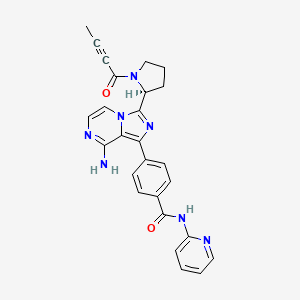



1. Acp-196
2. Calquence
1. 1420477-60-6
2. Acp-196
3. Calquence
4. Acalabrutinib (acp-196)
5. Acalabrutinib [inn]
6. I42748elqw
7. 4-[8-amino-3-[(2s)-1-but-2-ynoylpyrrolidin-2-yl]imidazo[1,5-a]pyrazin-1-yl]-n-pyridin-2-ylbenzamide
8. Benzamide, 4-(8-amino-3-((2s)-1-(1-oxo-2-butyn-1-yl)-2-pyrrolidinyl)imidazo(1,5-a)pyrazin-1-yl)-n-2-pyridinyl-
9. (s)-4-(8-amino-3-(1-(but-2-ynoyl)pyrrolidin-2-yl)imidazo[1,5-a]pyrazin-1-yl)-n-(pyridin-2-yl)benzamide
10. Acalabrutinib(acp196)
11. Acalabrutinib [usan:inn]
12. Acalabrutinibum
13. Unii-i42748elqw
14. Calquence (tn)
15. Benzamide, 4-[8-amino-3-[(2s)-1-(1-oxo-2-butyn-1-yl)-2-pyrrolidinyl]imidazo[1,5-a]pyrazin-1-yl]-n-2-pyridinyl-
16. Acp-196;acalabrutinib
17. Acalabrutinib [mi]
18. Acalabrutinib [jan]
19. Acalabrutinib [usan]
20. Acalabrutinib [who-dd]
21. Gtpl8912
22. Acalabrutinib (jan/usan/inn)
23. Chembl3707348
24. Schembl14637368
25. Acp 196
26. Amy5290
27. Ex-a881
28. Chebi:167707
29. Dtxsid401026209
30. Acalabrutinib [orange Book]
31. Bdbm50175583
32. Mfcd29472294
33. Nsc791164
34. Nsc800976
35. S8116
36. Zinc208774715
37. Ccg-269407
38. Cs-5356
39. Db11703
40. Ds-3326
41. Nsc-791164
42. Nsc-800976
43. Ncgc00479074-01
44. Hy-17600
45. Example 6 [us20140155385 A1]
46. D10893
47. A857446
48. J-690166
49. Q23668732
50. (s)-4-(8-amino-3-(1-(but-2-ynoyl)pyrrolidin-2-yl)imidazo[1,5-a]pyrazin-1-yl)-n-(pyridin-2-yl)benzamide;acalabrutinib
51. (s)-4-(8-amino-3-(1-but-2-ynoylpyrrolidin-2-yl)imidazo[1,5-a]pyrazin-1-yl)-n-(pyridin-2-yl)benzamide
52. 4-[8-amino-3-[(2s)-1-(1-oxo-2-butyn-1-yl)-2-pyrrolidinyl]imidazo[1,5-a]pyrazin-1-yl]-n-2-pyridinyl-benzamide
53. 4-[8-amino-3-[(2s)-1-but-2-ynoylpyrrolidin-2-yl]imidazo[1,5-a]pyrazin-1-yl]-n-(2-pyridyl)benzamide
54. 4-{8-amino-3-[(2s)-1-(but-2-ynoyl)pyrrolidin-2-yl]imidazo[1,5-a]pyrazin-1-yl}-n-(pyridin-2-yl)benzamide
| Molecular Weight | 465.5 g/mol |
|---|---|
| Molecular Formula | C26H23N7O2 |
| XLogP3 | 3 |
| Hydrogen Bond Donor Count | 2 |
| Hydrogen Bond Acceptor Count | 6 |
| Rotatable Bond Count | 4 |
| Exact Mass | 465.19132300 g/mol |
| Monoisotopic Mass | 465.19132300 g/mol |
| Topological Polar Surface Area | 119 Ų |
| Heavy Atom Count | 35 |
| Formal Charge | 0 |
| Complexity | 845 |
| Isotope Atom Count | 0 |
| Defined Atom Stereocenter Count | 1 |
| Undefined Atom Stereocenter Count | 0 |
| Defined Bond Stereocenter Count | 0 |
| Undefined Bond Stereocenter Count | 0 |
| Covalently Bonded Unit Count | 1 |
| 1 of 1 | |
|---|---|
| Drug Name | CALQUENCE |
| Active Ingredient | ACALABRUTINIB |
| Company | ASTRAZENECA (Application Number: N210259. Patents: 9290504, 9758524, 9796721) |
Acalabrutinib is currently indicated for the treatment of adult patients with Mantle Cell Lymphoma (MCL) who have received at least one prior therapy. It has also been recently approved for chronic lymphocytic leukemia and small lymphocytic lymphoma.
FDA Label
Calquence as monotherapy or in combination with obinutuzumab is indicated for the treatment of adult patients with previously untreated chronic lymphocytic leukaemia (CLL).
Calquence as monotherapy is indicated for the treatment of adult patients with chronic lymphocytic leukaemia (CLL) who have received at least one prior therapy.
Acalabrutinib is a Bruton Tyrosine Kinase inhibitor that prevents the proliferation, trafficking, chemotaxis, and adhesion of B cells. It is taken every 12 hours and can cause other effects such as atrial fibrillation, other malignancies, cytopenia, hemorrhage, and infection.
Antineoplastic Agents
Substances that inhibit or prevent the proliferation of NEOPLASMS. (See all compounds classified as Antineoplastic Agents.)
L01XE51
L - Antineoplastic and immunomodulating agents
L01 - Antineoplastic agents
L01E - Protein kinase inhibitors
L01EL - Bruton's tyrosine kinase (btk) inhibitors
L01EL02 - Acalabrutinib
Absorption
The geometric mean absolute bioavailability of acalabrutinib is 25% with a median time to peak plasma concentrations (Tmax) of 0.75 hours.
Route of Elimination
After administration of a single 100 mg radiolabelled acalabrutinib dose in healthy subjects, 84% of the dose was recovered in the feces and 12% of the dose was recovered in the urine. An irradiated dose of acalabrutinib was 34.7% recovered as the metabolite ACP-5862; 8.6% was recovered as unchanged acalabrutinub; 10.8 was recovered as a mixture of the M7, M8, M9, M10, and M11 metabolites; 5.9% was the M25 metabolite; 2.5% was recovered as the M3 metabolite.
Volume of Distribution
The mean steady-state volume of distribution is approximately 34 L.
Clearance
Acalabrutinib's mean apparent oral clearance (CL/F) is observed to be 159 L/hr with similar PK between patients and healthy subjects, based on population PK analysis.
Acalabrutinib is mainly metabolized by CYP3A enzymes. ACP-5862 is identified to be the major active metabolite in plasma with a geometric mean exposure (AUC) that is about 2-3 times greater than the exposure of acalabrutinib. ACP-5862 is about 50% less potent than acalabrutinib in regards to the inhibition of BTK.
After administering a single oral dose of 100 mg acalabrutinib, the median terminal elimination half-life of the drug was found to be 0.9 (with a range of 0.6 to 2.8) hours. The half-life of the active metabolite, ACP-5862, is about 6.9 hours.
Mantle Cell Lymphoma (MCL) is a rare yet aggressive type of B-cell non-Hodgkin lymphoma (NHL) with poor prognosis. Subsequently, relapse is common in MCL patients and ultimately represents disease progression. Lymphoma occurs when immune system lymphocytes grow and multiply uncontrollably. Such cancerous lymphocytes may travel to many parts of the body, including the lymph nodes, spleen, bone marrow, blood, and other organs where they can multiply and form a mass(es) called a tumor. One of the main kinds of lymphocytes that can develop into cancerous lymphomas are the body's own B-lymphocytes (B-cells). Bruton Tyrosine Kinase (BTK) is a signalling molecule of the B-cell antigen receptor and cytokine receptor pathways. Such BTK signaling causes the activation of pathways necessary for B-cell proliferation, trafficking, chemotaxis, and adhesion. Acalabrutinib is a small molecule inhibitor of BTK. Both acalabrutinib and its active metabolite, ACP-5862, act to form a covalent bond with a cysteine residue (Cys481) in the BTK active site, leading to inhibition of BTK enzymatic activity. As a result, acalabrutinib inhibits BTK-mediated activation of downstream signaling proteins CD86 and CD69, which ultimately inhibits malignant B-cell proliferation and survival Whereas ibrutinib is typically recognized as the first-in-class BTK inhibitor, acalabrutinib is considered a second generation BTK inhibitor primarily because it demonstrates highter selectivity and inhibition of the targeted activity of BTK while having a much greater IC50 or otherwise virtually no inhibition on the kinase activities of ITK, EGFR, ERBB2, ERBB4, JAK3, BLK, FGR, FYN, HCK, LCK, LYN, SRC, and YES1. In effect, acalabrutinib was rationally designed to be more potent and selective than ibrutinib, all the while demonstrating fewer adverse effects - in theory - because of the drug's minimized off target effects.
